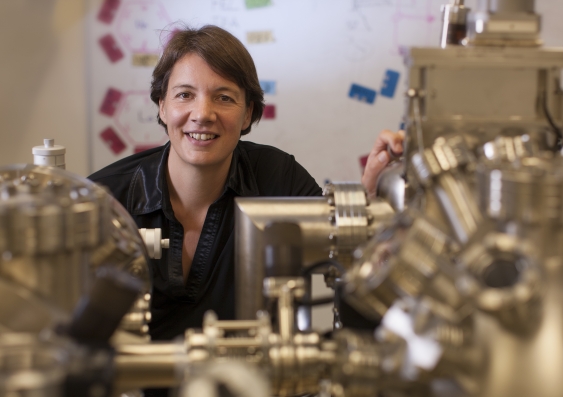Eureka nods for leadership celebrate UNSW women
Among UNSW’s stellar Eureka Prize finalists are quantum physicist Michelle Simmons and chemical engineer Rita Henderson, who are both nominated for major leadership awards.
Among UNSW’s stellar Eureka Prize finalists are quantum physicist Michelle Simmons and chemical engineer Rita Henderson, who are both nominated for major leadership awards.

The third time could be a charm for quantum physicist Michelle Simmons.
The director of the Australian Research Council Centre of Excellence for Quantum Computation & Communication Technology (CQC2T) is a contender for the 2015 CSIRO Eureka Prize for Leadership in Science for the third year running.
Scientia Professor Simmons is joined by UNSW chemical engineer Dr Rita Henderson, who is in the running for the 3M Eureka Prize for Emerging Leader in Science.
The two finalists berths for leadership are a major recognition of the depth of talent among UNSW’s female STEM researchers.
Simmons narrowly missed out in 2013 to nanotechnologist Frank Caruso from the University of Melbourne and in 2014 to statistician Terrence Speed from the Walter and Eliza Hall Institute of Medical Research.
Simmons – a former NSW Scientist of the Year – has had a plethora of other honours over that same period: she’s joined the likes of Stephen Hawking, Albert Einstein and Alexander Graham Bell as an elected member of the American Academy of Arts and Sciences and helped secure a $5 million investment in quantum computing from the Commonwealth Bank of Australia.
“The opportunities for women in science are vastly different compared to 50 years ago. Women compete at the highest levels and good things happen,” says Simmons, who was featured in Research@UNSW: 15 women changing our world.
She says it’s important to see more women in leadership roles in science because they tend to “think differently, they can bring unusual insights and balance” and because they are “generally very encouraging and supportive of others”.
Simmons, who was instrumental in developing the world’s first single atom transistor, is leading a multidisciplinary, cross-institutional team in the international race to build a large-scale quantum computer based in silicon, and will soon publish a study outlining an “ambitious full-scale architecture” for such a device.
Her job as Director of the CQC2T requires “hard work, endless energy and an attention to detail,” she says. “In the end though, if you love what you do, you will find fun in all aspects of the role.”
Simmons says universities can support female academics and leaders by offering “maximum support in childcare” and by “not overloading them with administrative work in the early stages of their careers”.
She also says it’s important to “celebrate our school teachers and ensure that they are strongly supported by the academic scientific community” as they play a fundamental role encouraging the next-generation of scientists and engineers.

Dr Rita Henderson
Dr Rita Henderson from the UNSW School of Chemical Engineering is also acutely aware of the need to inspire young people into STEM disciplines, and her nomination for the emerging leadership prize is, in part, due to her outreach work.
She has worked with a network called the Young Water Professionals, which is sponsored by the Australian Water Association, to improve public understanding of the water treatment industry, and to talk with high school students about engineering.
Henderson is also doing work with Engineers Without Borders (EWB), and is running a first year course where students complete an EWB challenge: “This is basically getting our students to think about humanitarian engineering,” she says. “We’re trying to get them to solve challenges faced by local communities in developing countries – mostly related to water purification.”
After studying environmental chemistry at Cranfield University in the UK, Henderson became interested in water engineering while working for an environmental consultancy. “We did a lot of contamination land assessments, and it just became clear that water pollution was a really big issue,” she says.
Today, her research is primarily aimed at characterising and treating algae blooms, which often occur in water reservoirs during the hotter summer months, and can release taste and odour molecules, as well as toxins, into drinking water.
From a water treatment perspective, it’s important to manage these blooms in a timely manner, and there’s also some interest in using algae for beneficial purposes, she says. For instance, captured algae can be converted to biogas or biodiesel to power treatment plants, while carefully orchestrated blooms within the plant itself could be used to help eradicate other chemicals in the water, such as nitrogen and phosphorus, which algae naturally feed on.
While she says she was “surprised” by the Eureka nomination, Henderson says it’s important to have more female leaders in science and technology so female students have “role models and can see it’s a valid career path”.
She also says it’s important for engineers and leaders in applied research disciplines to work well with industry: “I try hard to go out and talk to the water industry on a regular basis and get a good feel for what their problems and challenges are, and to come up with practical solutions.”
Professor Laura Poole-Warren, UNSW's Pro Vice-Chancellor (Research Training) and Dean of Graduate Research, says Professor Simmons and Dr Henderson have made enormous contributions at UNSW and to the wider community.
"Michelle is a role model for budding scientists around the world as well as being inspirational for women across all disciplines," says Professor Poole-Warren. "Rita, nominated as an emerging leader in Science is shaping up to be every bit as inspirational.
"The engagement of both women, and indeed all of our talented women researchers, in activities encouraging women into disciplines where they are underrepresented and supporting them in their goals is absolutely critical to the future health of the academy.
Nine UNSW researchers and a collaborative research team are finalists in this year’s prestigious Australian Museum Eureka Prizes. See the full list here.
The winners will be announced at a Gala Awards Dinner at Sydney Town Hall on 26 August 2015.